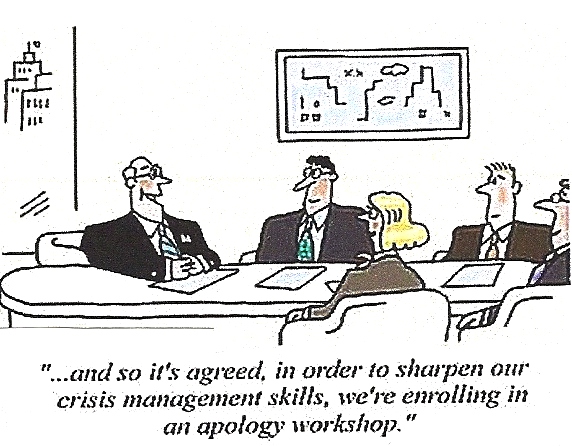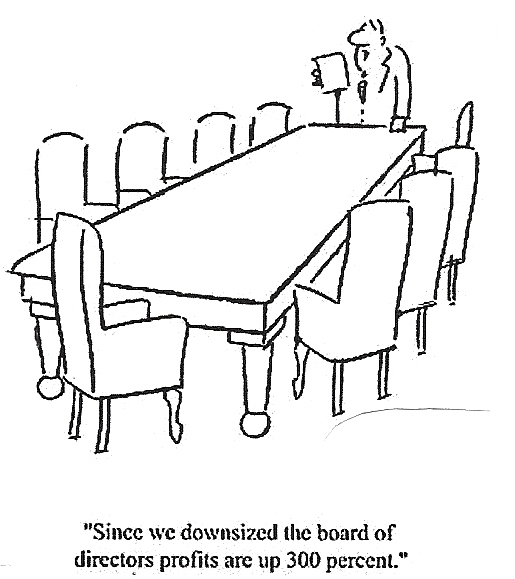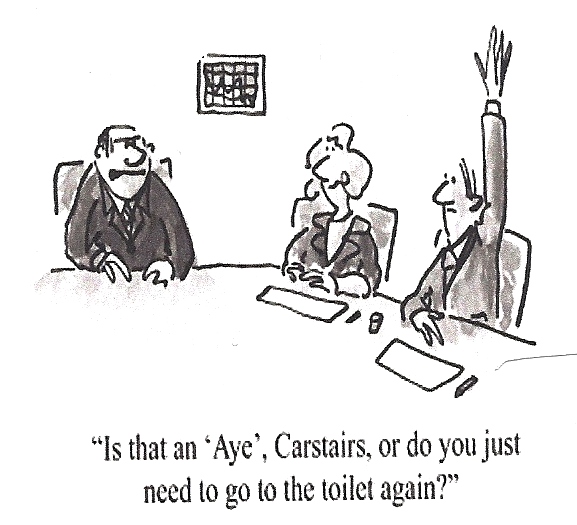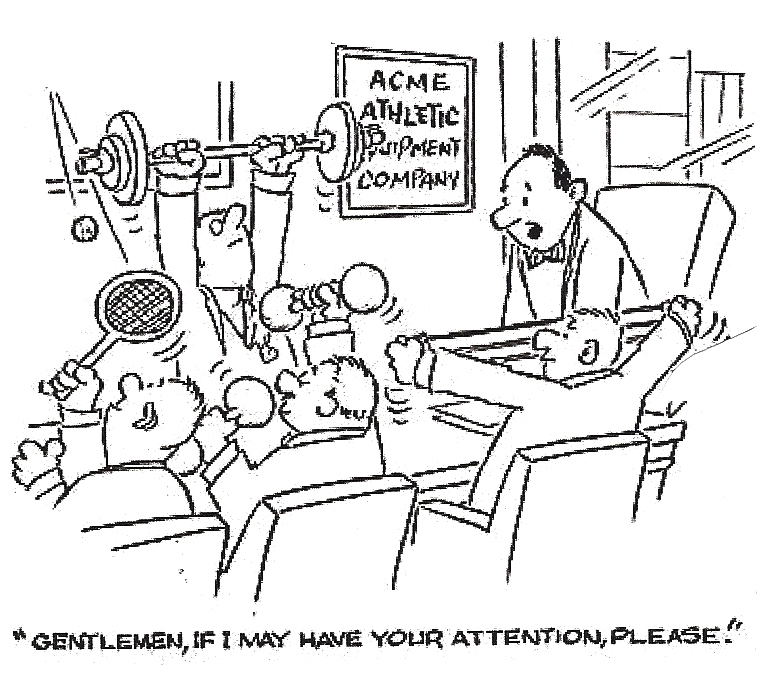
- •Improving Communications
- •Oral communications
- •Written communications
- •7 Tips to become a Good Conversationalist
- •Six Common Mistakes That Spoil Conversations
- •1. Blabbermouthing
- •2. The "take-away" and "me-too" syndrome
- •3. Unsolicited advice
- •4. Interrupting
- •5. Contradicting
- •6. Stingy contributors
- •8 Правил знайомства з діловими партнерами
- •18 Ways to improve your body language
- •6 Чарівних букв
- •Voice and Language
- •Visual aids
- •Fail to prepare
- •No weak opening
- •When I know I have to make a presentation, even a small one before a very limited number of people, I start feeling nervous…
- •When a big meeting is coming up, one that will involve a number of presentations from a range of people…
- •I would say my ability as a presenter is…
- •While I am up on stage, I…
- •Comments about my presentations are generally…
- •If I have to go “off the cuff”…
- •If I could describe public speaking as a food, it would be…
- •Visual aids versus handouts
- •Я к вдало провести ділову зустріч.
- •Introducing the Agenda
- •Introducing the First Item on the Agenda
- •1. What is the desired outcome of the meeting? (How will you know the meeting was successful?)
- •2. Who needs to be there? (And who doesn’t?)
- •3. Is the agenda prepared? (If not now, when?)
- •4. What can I do to prepare? (How can I help others prepare?)
- •5. What can I do to make this meeting succeed? (What is my responsibility?)
- •Discuss the following questions:
- •Exercise 6
- •Negotiating
- •Well, we could make it 7,5 % .
- •The trouble is, the general manager isn't very interested in marketing. He's only concerned about …..5…... If you make it 10%, I might be able to persuade him.
- •But you said…
- •6 Найпоширеніших помилок при проведенні переговорів
- •Communicating with someone in writing
- •The salutation
- •The subject title
- •The body of the letter
- •The parting
- •The signature
- •Inquiries (Enquiries)
- •Поради при написанні ділових листів
- •……………: Always proofread and edit your letters.
- •Avoid the use of …..1….. Words
- •Informal Style Formal Style
- •Identify yourself, if necessary
- •Include necessary information
- •Ten keys to writing an essay
- •Budget your time carefully
- •Read the topic carefully
- •Plan your essay before you write
- •Be sure your handwriting is as clear and legible as possible
- •Follow a clear, logical organization
- •Topic Type a: Contrast/Opinion
- •Use concrete examples and specific reasons
- •Use signal words to indicate transitions
- •Use a variety of sentence types.
- •Check your essay for errors.
- •Електронна пошта
- •Chief, Guy, Sport
- •My Buddy
- •Assumption Junction
- •Peak-a-Boo
- •2 (Suggested answer)
- •Listening 4
- •Contents
- •References
Я к вдало провести ділову зустріч.
Все в житті буває вперше. В тому числі і ділова зустріч. Як вона пройде і чим завершиться залежить від багатьох речей: пунктуальності, стриманості в суперечках та дебатах, від часу та місця зустрічі.
Першим кроком до успіху є пунктуальність. За статистикою кількість людей, що запізнюється становить 65%. І якщо результати зустрічі залежать від людини, яка чекала - то вважайте зустріч ви провалили. Є лише один спосіб уникнути такої ситуації - прийти раніше.
Другим кроком на шляху до успіху є ваша люб'язність. Незалежно від того з ким ви зустрічаєтесь - з клієнтом, конкурентом чи партнером, на етапі обміну люб'язностями - треба продемонструвати дружнє ставлення.
Ділову зустріч бажано призначати за 2-3 дні, щоб дати можливість запрошеному узгодити її з іншими справами.
Всі чудово розуміють, що на зустрічі потрібно вести себе стримано, бути зосередженим і уважним, але дуже часто люди роблять одну велику помилку. Це - розмови по мобільному телефону. Така розмова під час зустрічи - найгірше порушення етикету, пряма демонстрація неповаги до інших.
![]()
Chairing the meeting
1. Chairman is essential for business meetings. Look at the cartoons. Discuss with your partner the role of a chairperson at a meeting.
|
|
|
|
2. Fill in the gaps with the correct words from the box.
consultant allocated the time timekeeper agenda tactfully digression resolved organizer circulating venue take the minutes timetable early |
Robert Fris is a management …..1…..who specializes in meeting skills:
“A good chairperson has to be a good …..2….. . What they do before the meeting is as important as the meeting itself. They should make sure the …..3….. is complete by asking those involved what should be on it and then …..4…..it to everyone concerned.
They should check the …..5….. , making sure the room will be free, without interruptions, until the end of the meeting”.
The chairperson should be a good …..6….. . He should start a meeting on time without waiting for latecomers. He should appoint a minute-taker to …..7….. , making sure that opinions and action points (where participants agree to do something) is noted. He should make sure each point on the agenda is …..8…..it deserves and should keep to the …..9….. . When the time allocated to one point is up, the chair should make sure that discussion moves on to the next point, even if the issue has not been completely …..10….. . The chair should make sure that each participant has the chance to make his point, and should deal …..11…..with disagreements, making sure that each side feels their point of view has been noted. They should also try to avoid …..12….. , where people get off the point. Finally, they should ensure the meeting finishes on time, or …..13….. .
![]()
1. Listen to a recording of a meeting at Hilo Vo., a small subsidiary of a multinational company. The meeting is to discuss the decline in profits. Listen once. Say which of the following are given as reasons for the fall.
Prices are too high.
The company has wasted money on research and development.
Sales are down.
The sales budget is too low.
No one likes the Chief Sales Executive.
The products are old.
2. Listen again, paying attention to the role of the chair in the discussion. Tick (v) which of the following functions the chair performs at this meeting.
Thanks people for coming |
Prevents interruptions |
Starts the meeting on time |
Makes people stick to the subject |
States the objective |
Gives a personal opinion |
Refers to the agenda |
Summarizes |
Changes the agenda |
Asks for comments |
Talks about a previous meeting |
Decides when to have a break |
Introduces the first speaker |
Closes the meeting |
Take an interview from a person who is an expert in chairing different meetings. Discuss the personal traits the chairperson should possess as well as the tasks he has to perform during the meeting. Don’t forget about tips. Use Do and Don’t advice.
Do
Personally welcome new people
Actively listen to others
Support the facilitator in moving the agenda ahead
Recommend ways to resolve differences
Participate in discussions
Encourage new people to speak and volunteer
Help set up and clean up the room
Be positive and upbeat throughout the meeting
Tell a joke or add a light comment to ease the tension in a difficult discussion.
Don't
Dominate the discussion
Bring up tangents
Dwell on past problems
Insist that people support your ideas.
Exercise 1
Business Meetings in English
The following dialogue is an example of a typical business meeting. As you can see from the dialogue, a typical business meeting can be divided into five parts.
Read the dialogue and give the title to each part.
Beginning the meeting
Reviewing past business
Introductions
Finishing the meeting
Discussing items
1 ________________
Meeting Chairman: If we are all here, let's get started. First of all, I'd like you to join me in welcoming Jack Peterson, our Southwest Area Sales Vice President.
Jack Peterson: Thank you for having me, I'm looking forward to today's meeting.
Meeting Chairman: I'd also like to introduce Margaret Simmons who recently joined our team.
Margaret Simmons: May I also introduce my assistant, Bob Hamp.
Meeting Chairman: Welcome Bob. I'm afraid our national sales director, Anne Trusting, can't be with us today. She is in Kobe at the moment, developing our Far East sales force.
2 ________________
Meeting Chairman: Let's get started. We're here today to discuss ways of improving sales in rural market areas. First, let's go over the report from the last meeting which was held on June 24th. Right, Tom, over to you.
Tom Robbins: Thank you Mark. Let me just summarize the main points of the last meeting. We began the meeting by approving the changes in our sales reporting system discussed on May 30th. After briefly revising the changes that will take place, we moved on to a brainstorming session concerning after sales customer support improvements. You'll find a copy of the main ideas developed and discussed in these sessions in the photocopies in front of you. The meeting was declared closed at 11.30.
3 ________________
Meeting Chairman: Thank you Tom. So, if there is nothing else we need to discuss, let's move on to today's agenda. Have you all received a copy of today's agenda? If you don't mind, I'd like to skip item 1 and move on to item 2: Sales improvement in rural market areas. Jack has kindly agreed to give us a report on this matter. Jack?
4 ________________
Jack Peterson: Before I begin the report, I'd like to get some ideas from you all. How do you feel about rural sales in your sales districts? I suggest we go round the table first to get all of your input.
John Ruting: In my opinion, we have been focusing too much on urban customers and their needs. The way I see things, we need to return to our rural base by developing an advertising campaign to focus on their particular needs.
Alice Linnes: I'm afraid I can't agree with you. I think rural customers want to feel as important as our customers living in cities. I suggest we give our rural sales teams more help with advanced customer information reporting.
Donald Peters: Excuse me, I didn't catch that. Could you repeat that, please?
Alice Linnes: I just stated that we need to give our rural sales teams better customer information reporting.
John Ruting: I don't quite follow you. What exactly do you mean?
Alice Linnes: Well, we provide our city sales staff with database information on all of our larger clients. We should be providing the same sort of knowledge on our rural customers to our sales staff there.
Jack Peterson: Would you like to add anything, Jennifer?
Jennifer Miles: I must admit I never thought about rural sales that way before. I have to agree with Alice.
Jack Peterson: Well, let me begin with this Power Point presentation (Jack presents his report).
Jack Peterson: As you can see, we are developing new methods to reach out to our rural customers.
John Ruting: I suggest we break up into groups and discuss the ideas we've seen presented.
5 _______________
Meeting Chairman: Unfortunately, we're running short of time. We'll have to leave that to another time.
Jack Peterson: Before we close, let me just summarize the main points:
Rural customers need special help to feel more valued.
Our sales teams need more accurate information on our customers.
A survey will be completed to collect data on spending habits in these areas.
The results of this survey will be delivered to our sales teams.
We are considering specific data mining procedures to help deepen our understanding.
Meeting Chairman: Thank you very much Jack. Right, it looks as though we've covered the main items. Is there any other business?
Donald Peters: Can we fix the next meeting, please?
Meeting Chairman: Good idea Donald. How does Friday in two weeks time sound to everyone? Let's meet at the same time, 9 o'clock. Is that OK for everyone? Excellent. I'd like to thank Jack for coming to our meeting today. The meeting is closed.
Exercise 2
This example business meeting is followed by the two sections which provide key language and phrases appropriate for typical business meetings.
Look through the key language and phrases. Then read the dialogue in Exercise 1 again using alternative vocabulary from sections A and B.
Language checklist
A
Chairing and leading discussion
Opening the Meeting
Good morning/afternoon, everyone. If we are all here, let's . . . get started (OR) start the meeting. (OR) . . . start.
Welcoming and Introducing Participants
Please join me in welcoming (name of participant) We're pleased to welcome (name of participant) It's a pleasure to welcome (name of participant) I'd like to introduce (name of participant) I don't think you've met (name of participant)
Stating the Principal Objectives of a Meeting
We're here today to… Our aim is to ... I've called this meeting in order to ... By the end of this meeting, I'd like to have ...
Giving Apologies for Someone Who is Absent
I'm afraid.., (name of participant) can't be with us today. She is in... I have received apologies for the absence of (name of participant), who is in (place).
Reading the Minutes (Notes) of the Last Meeting
First let's go over the report from the last meeting, which was held on (date) Here are the minutes from our last meeting, which was on (date)
Dealing with Recent Developments
Jack, can you tell us how the XYZ project is progressing? Jack, how is the XYZ project coming along? John, have you completed the report on the new accounting package? Has everyone received a copy of the Tate Foundation report on current marketing trends?
Moving Forward
So, if there is nothing else we need to discuss, let's move on to today's agenda. Shall we get down to business? Is there any other business? If there are no further developments, I'd like to move on to today's topic.




